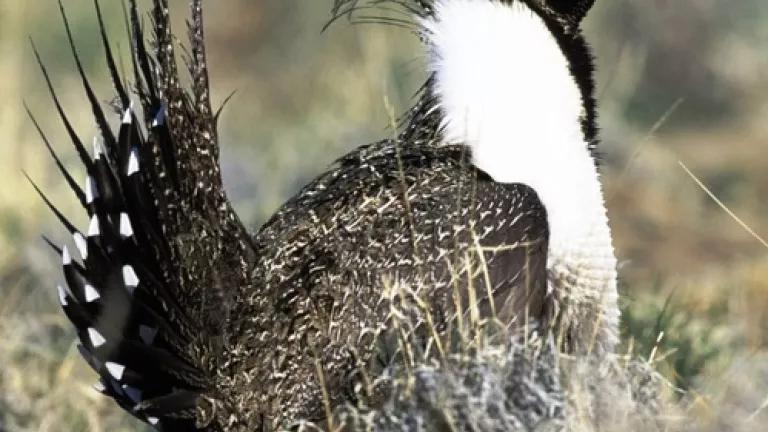
A 1979 U.S. Bureau of Land Management (BLM) publication stated that “the future of the sage grouse, which occurs throughout most of the sagebrush-covered lands of the West, depends largely upon man’s ability and willingness to maintain habitat vital to its needs.” Thirty-five years later, it seems as if man has been less than able and less than willing to maintain the sagebrush habitat that these birds depend on.
Today, sage grouse continue to face the threat of habitat loss. Their numbers have decreased such that the International Union for Conservation of Nature (IUCN) considers the greater sage grouse a near-threatened species. Per a settlement agreement, the U.S. Fish and Wildlife Service must determine whether or not to propose the species for listing under the Endangered Species Act by September 2015.
Habitat loss is a severe problem for sage grouse, who depend on sagebrush to meet their life requirements. In the spring nesting season, more than 90% of nests are under or next to sagebrush plants. In the fall, sage grouse use a variety of sagebrush grassland habitat en route to their wintering grounds. And in the winter, sage grouse diets are made up, almost exclusively, of sagebrush leaves.
Threats to sagebrush, and thus sage grouse habitat, include fire, conversion of lands to facilitate livestock grazing, invasion of non-native plant species such as cheatgrass, encroachment of native conifers, and the use of lands for energy and mineral development. Coal fields in Montana, Wyoming, and Colorado are in fact coterminous with large portions of the greater sage grouse’s range.
Coal-mining poses a two-fold problem for sage grouse habitat. While the initial act of mining clearly removes available habitat, there are also problems related to reclamation, the process of re-establishing vegetation and water resources on formerly mined lands as required under the Surface Mining Control and Reclamation Act (SMCRA). The goal of reclamation – to return mined lands to their pre-mining conditions, or approved post-mining beneficial uses – helps to ensure restoration of wildlife habitat, but reality dictates that the number of factors involved in reclamation often delays or inhibits its successful realization.
There is some evidence that sage grouse will use mined lands that are successfully reclaimed, but accomplishments on this front may be many years in the making. Data from Colorado’s Trapper Mine indicate that “when sage grouse do use reclaimed lands, it is land that has been in reclaimed status for 15 to 20 years.”
When we consider the slow rate of reclamation in the West, the implications of such data are especially troubling; according to data from the Office of Surface Mining (OSM), the percentage of reclaimed land to total acres bonded for current or future disturbance by mining – cumulative over the years 1996 to 2013 and aggregated for five western states (Colorado, Montana, New Mexico, North Dakota, and Wyoming) – stands at a mere 7.1%.
Reclamation personnel may also face difficulties in reestablishing sagebrush on mined lands, causing further delays in habitat restoration. Extensive research has shown that successful reestablishment depends on several factors, including seed quality, seeding rate, winter and early spring precipitation, mulching, and topsoil management. A failure to use best practices or a lack of sufficient precipitation or irrigation – which can be a problem in the arid West – can therefore hinder reclamation efforts.
Some have suggested mitigation banking as a solution to habitat loss – the idea is to allow development on sage grouse habitat, as long as similar habitat is restored or enhanced elsewhere. Even if sage grouse use these alternative areas, however, the loss of habitat that nevertheless occurs can result in fragmentation that disrupts migration patterns and separates populations.
Ensuring the future of the sage grouse requires closely examining claims that we can effectively reduce mining impacts to these birds through such practices as reclamation and mitigation banking. While coal mining may not by itself decisively threaten the survival of sage grouse, the cumulative impacts it would have in combination with other threats to this species very well could.
**Photo credit: Gary Kramer, U.S. Fish and Wildlife Service.Public domain image.Image source: http://www.sagebrushsea.org/sage_grouse_images.htm
